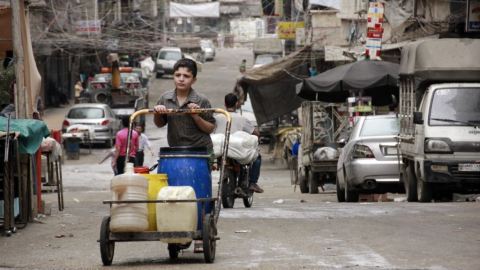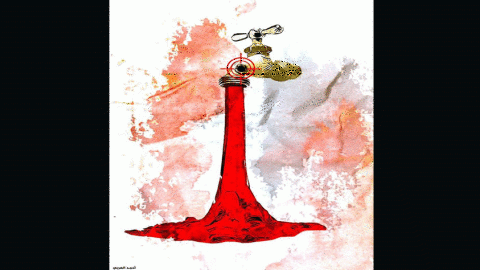Aleppo, the city that has survived two years of Assad’s barrel bombs, is now being brought to its knees by thirst. But this time, the direct culprit is not the regime.
Activists have pointed the finger at radical Islamist opposition militias, specifically al-Nusra Front—an al-Qaeda-linked group that has attempted to impose its own Islamic interpretation on Syrians under the guise of the revolution— that are in control of Aleppo’s main water pumping station. They are accused of refusing to allow water to be pumped to the city as a way of putting pressure on regime-controlled areas with utter disregard to the unfolding humanitarian disaster in the town.
An avoidable tragedy
Guevara Naby, a member of the Arab-Kurdish Fraternity Coordination Committee, explains the situation in an interview with SyriaUntold: “The blame lies squarely with Jabhat al-Nusra and the Islamic Council, who controlled the water network in the city.” Their strategy of cutting water supplies to put pressure on the regime enclaves was soon proved wrong, as civilians were the only ones affected. "They don't care", Naby adds. "They cynically continued to do it, as a way to bring down the temple"
A major breakthrough seemed to come around when civil society organization Madani (“civil” in English released an urgent appeal for a ceasefire in the city, and the restoration of services to all citizens. The ceasefire lasted only hours before being broken by more artillery bombardment by the regime. Despite the eventual failure of the initiative, it was instrumental in focusing attention on the escalating humanitarian situation.
The water crisis has significantly contributed to a major health hazard as well. As the weather becomes hotter, and more and more get their drinking water from swampy wells, diseases such as Leishmania are on the rise. This is compounded by the destruction of all healthcare infrastructure of the city during the ongoing battles, and the lack of qualified medical staffs.
Aleppo, already on the verge of despair, finds itself in the middle of a brutal war that leaves little consideration for the town and its inhabitants.The latest agreement between the regime and the Islamic Front stipulated that both sides must put an end to the humanitarian disaster in the city. However, in reality, the regime decided to bring supplies to two villages only in the Aleppo governorate with a predominantly loyalist population. The Islamist militias were guilty of the same policy in bringing supplies to areas loyal to them only. The disputed areas of Aleppo city are thus left to their devices.
Civil society responses
Several civil society initiatives were mobilized to ease the city’s suffering. One such initiative fitted existing small pickup trucks with small water pumps and water tanks so that water could be more easily pumped from wells and distributed to houses with minimal costs.
Dubarah put together a comprehensive list of churches, mosques and old houses that have built-in wells. The list was distributed in the city along with suggestions on how to purify the water, and the most efficient ways of transporting it across different neighborhoods.
Artists also responded to the crisis in their own ways. Ahmad al-Arabi’s painting, titled “besieging a water faucet”, shows how water has turned into blood in the city. While Wajdi Saleh’s work reflects on how water became another weapon to kill Syrians.
Aleppo continues to bear the cross of Syria’s revolution, but its slow suffocation of thirst is adding a great deal of insult to its massive injuries. Especially considering that this particular tragedy was, and still is, wholly avoidable.





